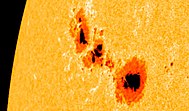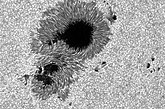Sunspots
|
||||
|
||||
| Heliophysics | |
| Phenomena | |
|---|---|
Sunspots are temporary phenomena on the photosphere of the Sun that appear as dark spots compared to surrounding regions. They are areas of reduced surface temperature caused by concentrations of magnetic field flux that inhibit convection. Sunspots usually appear in pairs of opposite magnetic polarity. Their number varies according to the approximately 11-year solar cycle.
Individual sunspots may endure anywhere from a few days to a few months, but eventually decay. Sunspots expand and contract as they move across the surface of the Sun with sizes ranging from 16 kilometers (10 mi) to 160,000 kilometers (100,000 mi) in diameter. The larger variety are visible from Earth without the aid of a telescope. They may travel at relative speeds, or proper motions of a few hundred meters per second when they first emerge.
Indicating intense magnetic activity, sunspots accompany secondary phenomena such as coronal loops (prominences) and reconnection events. Most solar flares and coronal mass ejections originate in magnetically active regions around visible sunspot groupings. Similar phenomena indirectly observed on stars other than the sun are commonly called starspots and both light and dark spots have been measured.
Although they are at temperatures of roughly 3,000–4,500 K (2,700–4,200 °C), the contrast with the surrounding material at about 5,780 K (5,500 °C) leaves sunspots clearly visible as dark spots. This is because the luminance (which is essentially "brightness" in visible light) of a heated black body (closely approximated by the photosphere) at these temperatures varies extremely with temperature—considerably more so than the (temperature to the fourth power) variation in the total black-body radiation at all wavelengths (see Stefan–Boltzmann law). Isolated from the surrounding photosphere a sunspot would be brighter than the Moon.
...
Wikipedia





